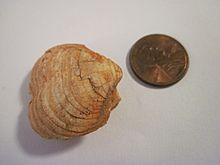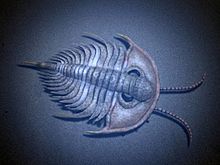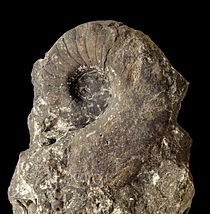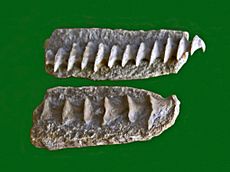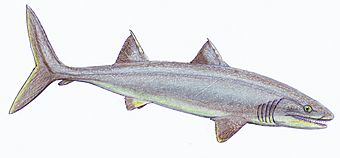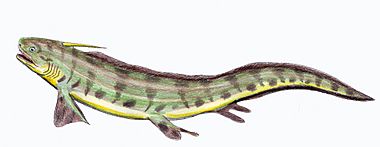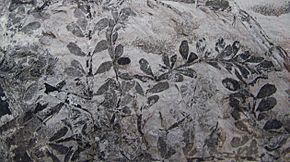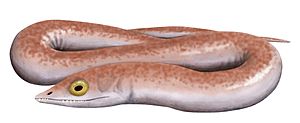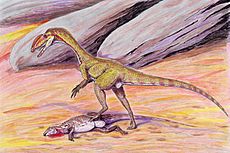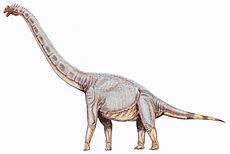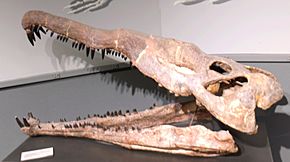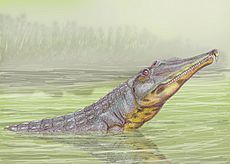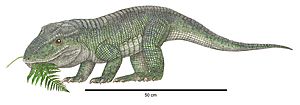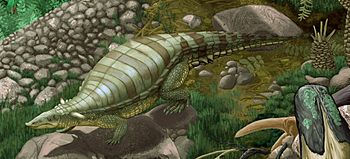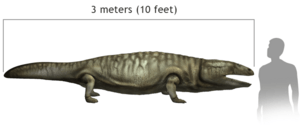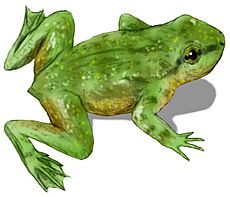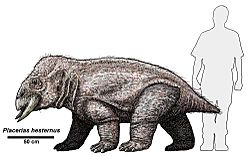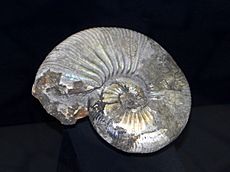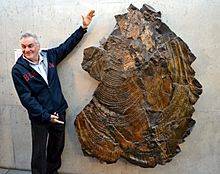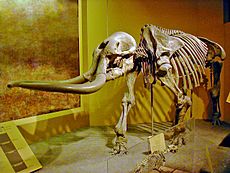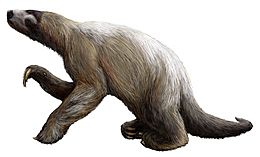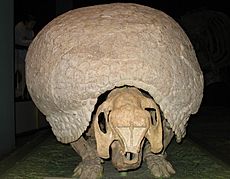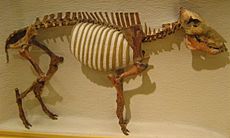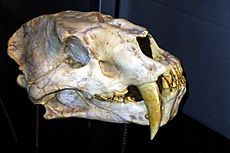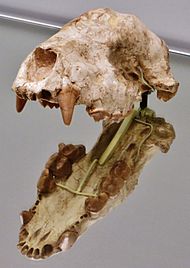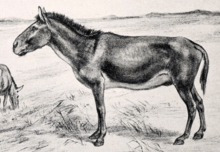List of the prehistoric life of Arizona facts for kids
Arizona is a fantastic place to discover the ancient world! This article explores the amazing prehistoric creatures and plants whose fossilized remains have been found right here in Arizona. Fossils are like clues from the past, showing us what life was like millions of years ago.
Contents
Ancient Life in Arizona: The Precambrian Era
The Precambrian Era was the earliest time in Earth's history, long before complex animals appeared. Scientists haven't found any known fossils from this very ancient time in Arizona. This means that either no life existed here then, or any tiny, soft-bodied creatures didn't leave behind any fossil clues.
Life in the Paleozoic Era: The Age of Fish and Early Land Life
The Paleozoic Era lasted from about 541 to 252 million years ago. During this time, life exploded in the oceans, and then creatures slowly began to move onto land. Arizona was often covered by shallow seas, which is why we find many marine fossils from this period.
Ocean Dwellers of the Paleozoic
Many creatures lived in the ancient seas that covered Arizona.
- Brachiopods: These shelled animals, like †Composita, looked a bit like clams but are a different group. They were very common in the Paleozoic oceans.
- Trilobites: These ancient sea arthropods, such as †Olenellus and †Elrathia, are some of the most famous fossils from the Paleozoic. They had segmented bodies and hard exoskeletons.
- Nautiloids: Creatures like †Metacoceras were ancient relatives of modern squids and octopuses. They lived inside coiled shells.
- Bryozoans: Tiny colonial animals like †Archimedes formed spiral-shaped colonies. They filtered food from the water.
- Sharks: Even ancient sharks, like †Glikmanius and †Triodus, swam in Arizona's waters. These early sharks looked different from today's sharks.
Plants and Early Land Animals
As the Paleozoic continued, plants and animals began to colonize land.
- Ancient Plants: Fossils of plants like †Calamites, a relative of modern horsetails, and †Sphenophyllum, another horsetail relative, show that forests started to grow.
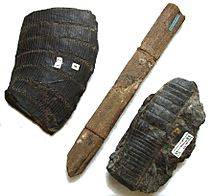
- Amphibians: Early amphibians, like †Arizonerpeton and †Phlegethontia, were among the first vertebrates to live on land, though they still needed water to reproduce.
Life in the Mesozoic Era: The Age of Dinosaurs
The Mesozoic Era, from about 252 to 66 million years ago, is famous for dinosaurs! Arizona has many important fossil sites from this time, especially from the Triassic and Jurassic periods.
Dinosaurs and Their Relatives
Arizona was home to many types of dinosaurs and their close relatives.
- Early Dinosaurs: †Camposaurus and †Chindesaurus were some of the earliest known dinosaurs, found in Arizona. They were small, meat-eating theropods.
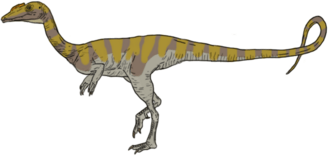
- Famous Theropods: †Dilophosaurus, known for its two crests on its head, was a large predator from the Early Jurassic. †Coelophysis kayentakatae was another theropod found here.
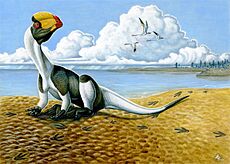
- Armored Dinosaurs: †Scutellosaurus was a small, early armored dinosaur. It had bony plates embedded in its skin for protection.

- Plant-Eaters: †Tenontosaurus was a medium-sized plant-eating dinosaur, related to Iguanodon.

- Giant Sauropods: †Sonorasaurus was a huge, long-necked dinosaur, a type of brachiosaur. It was one of the largest animals to ever live in Arizona.
- Crocodile Relatives: Animals like †Arizonasaurus, †Hesperosuchus, †Leptosuchus, †Machaeroprosopus, †Revueltosaurus, †Smilosuchus, and †Typothorax were not true crocodiles but ancient relatives called phytosaurs and aetosaurs. They often had long snouts and bony armor.
Other Mesozoic Life
- Amphibians: †Metoposaurus was a large, flat-headed amphibian that lived in ancient rivers and lakes. †Prosalirus was an early frog.
- Mammal Precursors: †Placerias was a large, tusked animal that looked a bit like a hippo. It was a synapsid, an ancient relative of mammals. †Oligokyphus was another mammal precursor.
- Ancient Trees: The famous petrified wood of Arizona comes from trees like †Araucarioxylon arizonicum. These ancient conifers grew in vast forests.
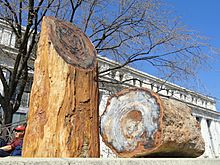
- Marine Life: Even during the Age of Dinosaurs, parts of Arizona were covered by seas. Fossils of ammonites like †Acanthohoplites and †Inoceramus, a giant clam, show us what lived in these waters.
Life in the Cenozoic Era: The Age of Mammals
The Cenozoic Era began about 66 million years ago and continues to this day. After the dinosaurs disappeared, mammals became the dominant large animals. Arizona's landscape changed, with mountains forming and deserts appearing.
Mammals of the Cenozoic
Many familiar types of mammals, and some extinct ones, roamed Arizona during the Cenozoic.
- Giant Mammals:
- Mammoths and Mastodons: Huge elephant relatives like †Mammuthus columbi (Columbian mammoth) and †Stegomastodon lived in Arizona.
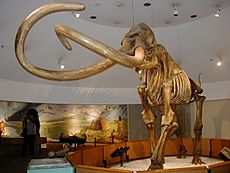
-
- Giant Ground Sloths: †Nothrotheriops and †Megalonyx were large, slow-moving ground sloths.
-
- Camels: †Camelops was a large, extinct camel that lived in North America.
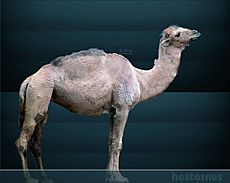
-
- Glyptodonts: †Glyptotherium was a giant armadillo-like animal with a huge, bony shell.
-
- Peccaries: †Platygonus was an extinct type of peccary, a pig-like animal.
- Predators:
- Saber-toothed Cats: †Amphimachairodus and †Homotherium were types of saber-toothed cats, famous for their long, sharp canine teeth.
-
- Dire Wolves: †Canis dirus was a large, powerful wolf that lived alongside mammoths and other megafauna.
- Bears: †Arctodus (short-faced bear) and †Indarctos were large bears that once roamed Arizona.
- Horses: †Equus scotti and †Nannippus were ancient horse species that lived in Arizona.
- Other Animals: Many other animals, including rabbits like †Aztlanolagus, deer, rodents, and bats, have left their fossil records in Arizona. Even modern animals like Bison and Panthera leo (lion) have prehistoric relatives found here.
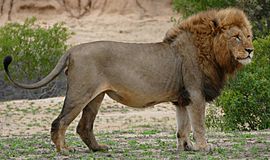
Images for kids


